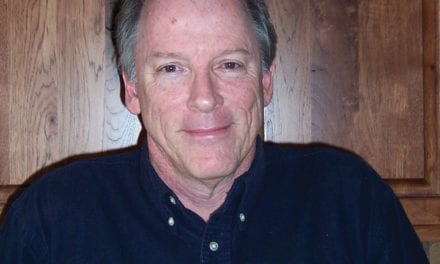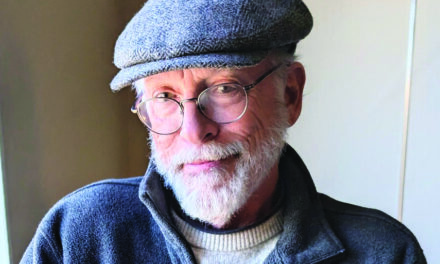This month’s column is contributed by Conifer Rotarian Leonor McCall-Rodriguez, who interviewed her friend and longtime Conifer resident, Carol Carper. Carol is a former member of both Rotary Clubs of Evergreen and Conifer.
Carol’s work is well-known in our community and her many achievements include being one of the founders of the Mountain Resource Center, a potter artist, a kindergarten teacher at Bailey’s Deer Creek Elementary, and the Early Childhood Director at Red Rocks Community College. She loves teaching to all ages and is a lifelong community organizer. Carol is a constant inspiration to Coloradans who are privileged to call her “friend.” Her frequent newsletters offer insights into the latest projects of the nonprofit, Sasa Harambee, which she cofounded. Carol will be visiting Colorado in late Summer.
Leonor and Carol recently “Zoomed” to catch up on Carol’s activities in her home of Sigomere, Kenya, an undeveloped subsistence agricultural community in rural western Kenya. Here is Leonor’s interview with Carol:
Leonor: We’re eager to hear about news from Sigomere, but first, Carol, can you share a little with Serenity readers about how a woman from Colorado came to work in Kenya?
Carol: When I was 10 years old, my mother gave me a book about Albert Schweitzer’s work with lepers in South Africa and I declared, “Someday I want to visit there.’’ In 1999, my daughter passed away and I began searching for new meaning in my life. Things came together. I visited Tanzania and returned certain that I wanted to help in Africa. I joined the Conifer Rotary Club where I found like-minded people focused on “Service above Self.” I also met a very special co-traveler in America, Dr. Meshach Onguti, a world-renowned maxi facial surgeon who invited me to Kenya to help him in his work with children with cleft palate. While there, I searched for places that needed water, a hallmark project of Rotary International. I met Dr. George Oyeho, a Minneapolis Rotarian who invited me to visit his hometown in Kenya. Through his eyes, I saw a place where I might participate in long-term community service projects. So, in 2008, I journeyed from the foothills to Kenya and began my work in Sigomere.
Leonor: Tell us about Sasa Harambee and how it operates.
Carol: Sasa Harambee is Swahili for “Let’s pull together now!” In 2008, George and I founded a U.S.-based nonprofit to support our work in Kenya. We work with CBOs (Community Based Organizations) to identify needs, design community-based solutions, seek resources, and deliver them for programs. In recent years, we’ve launched several Kenyan CBOs to facilitate programs like SOAP (Soap Organic Agriculture Program), and Together We Succeed (serving Persons Living with Disabilities), and we collaborate with the teen-centered Ugunja Development Initiative. The newest community group we’ve launched, Sasa Hapo, will serve a larger area with 1 million residents. All this work, including leadership development, is made possible by generous donors in the United States and other nations. And, notably, 100 percent of Sasa Harambee donations still go directly to Kenya to benefit the people. We have no Harambee paid staff in America and our activities are carried out by volunteers or paid by contract with funds from other sources.
Leonor: I know you began your work with an organic farming program. What is new there?
Carol: In 2009, an initial Rotary International grant funded organic farming training for 50 farmers to plant hay. Now 16 farmer teachers are leading and guiding local farmers in organic farming practices. Women comprise 73 percent of SOAP’s leadership team and 63 percent of farmer teachers. The organic farming method taught by SOAP, Push/Pull, has proven effective. 345 farmers are now selling hay and generating income through the SOAP cooperative. Farmer teachers have benefited from Buffalo Bikes (a bicycle designed for African terrain) and smartphones, thanks to supporters’ Facebook fundraisers and grants.
Leonor: Tell us about your other ongoing projects.
Carol: Our Water Project is expanding. In 2015-2016, with funds from Evergreen and Conifer Rotarians, Interact (Rotary service clubs for teens) at Fitzsimmons Middle School, and others, Sasa Harambee put in 13 springs protections (piping and filtration for natural springs). Eleven of these are still in operation and provide clean water to many families. Protections drove waterborne disease morbidity to zero in a year. Sasa Harambee will receive a new Rotary grant this year to add 26 springs protections in new locations.
We also have a new art program for children. Obam, a fellow community member, and I teach a weekly art class at a local primary school. The school has had no materials for art. A #2 pencil is all teachers and students have ever had to draw with. The kids routinely ask their teachers: “Is today art day?” They love it!
We continue our successful partnership with Together We Succeed, a local organization focused on improving the lives of Persons Living with Disabilities (PWDs). We led training of clinical and community health workers in identification of disabilities and the door-to-door census of persons with disabilities. Our database will now serve as a health and policy planning resource.
In 2018, the Rotary Interact clubs of Fitzsimmons Middle School and Conifer High School made the dream of a playground at Small Home, a boarding place for children living with disabilities, a reality. It is another example of how foothills’ families have improved lives in Sigomere.
Leonor: And what’s next for Sasa Harambee and Sigomere?
Carol: Though Dr. George Oyeho and I now live full time in Kenya, our vision is to establish and build a sustainable development model that will survive us and be replicated across other developing African communities. With the support and generosity of Americans and Coloradans, the 345 Sigomere farmers who are steadily growing their income are proof that the Sasa Harambee development model works.
While people in our programs are no longer in immediate risk of hunger, our next step is to work toward raising their income levels and building product management and business skills. We are currently establishing aggregation centers in 10 areas for buyers to pick up their hay and work toward increasing hay production and buying land to install model hay plantations to increase dependable yield. Barns for storage are part of our dream. Adding other streams of income like milled products, milk, vegetables, juice, jellies and cheese is being discussed for the future.
In closing, I want Serenity readers to know that I live in gratitude for the support of our foothills’ communities and the love and kindness you constantly share with Sigomere. We are of one heart, though we are in different geographies. If you would like to learn more about our work, donate or subscribe to our newsletter, please visit SasaHarambee.org or email me at [email protected].




